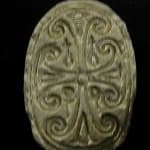Egyptian Steatite Scarab
0.75
LO.1123
The ancient Egyptians maintained that the sun was propelled across the heavens by means of a scarab, or sacred beetle. With the passing of time, the Egyptians created a series...
The ancient Egyptians maintained that the sun was propelled across the heavens by means of a scarab, or sacred beetle. With the passing of time, the Egyptians created a series of amulets in the form of this beetle in a great variety of materials, and these were routinely provided with inscriptions in hieroglyphs conveniently accommodated to their stylized flat bottoms.
Our scarab is just such a variation with a remarkable degree of ornamentation on its upper side, the perimeter of which relies on a notched pattern. The details of the head, plate, and clypeus are well done as are those of the thorax and elytra, or wing case, both elements of which are additionally decorated with “curls,” to use Petrie’s designation.
The bottom of our scarab is decorated with a cruciform motif in the form of stylized floral forms, perhaps to be identified as the lotus. There is a single nefer sign in the field to the left and right of the upper shaft of the cruciform floral element and a single ankh sign in each of the corresponding fields of the lower shaft.
Such motifs, which may have originally been imbued with magical properties, were first introduced in the Middle Kingdom and were repeatedly encountered on scarabs of later periods. The unique curl designs on our scarab suggest a dating within Dynasty XXV, when such decorative accents enjoyed great popularity. This was the dynasty during which time the Nubians ruled Egypt as pharaohs in their own right. They projected themselves as ardent worshippers of the state god Amun and aggressively fought against the Assyrians in order to preserve Egypt’s independence.
References:
For a discussion of these cruciform designs, see, Daphna Ben-Tor, The Scarab. A Reflection of Ancient Egypt (Jerusalem 1993, page 31; an W. M. Flinders Petrie, Scarabs and Cylinders with Names (London 1917), pages lii with plates lii and LXVII, Q, for scarabs with such curl ornamentation.
Description and interpretation kindly provided by prof. Robert S. Bianchi.
Our scarab is just such a variation with a remarkable degree of ornamentation on its upper side, the perimeter of which relies on a notched pattern. The details of the head, plate, and clypeus are well done as are those of the thorax and elytra, or wing case, both elements of which are additionally decorated with “curls,” to use Petrie’s designation.
The bottom of our scarab is decorated with a cruciform motif in the form of stylized floral forms, perhaps to be identified as the lotus. There is a single nefer sign in the field to the left and right of the upper shaft of the cruciform floral element and a single ankh sign in each of the corresponding fields of the lower shaft.
Such motifs, which may have originally been imbued with magical properties, were first introduced in the Middle Kingdom and were repeatedly encountered on scarabs of later periods. The unique curl designs on our scarab suggest a dating within Dynasty XXV, when such decorative accents enjoyed great popularity. This was the dynasty during which time the Nubians ruled Egypt as pharaohs in their own right. They projected themselves as ardent worshippers of the state god Amun and aggressively fought against the Assyrians in order to preserve Egypt’s independence.
References:
For a discussion of these cruciform designs, see, Daphna Ben-Tor, The Scarab. A Reflection of Ancient Egypt (Jerusalem 1993, page 31; an W. M. Flinders Petrie, Scarabs and Cylinders with Names (London 1917), pages lii with plates lii and LXVII, Q, for scarabs with such curl ornamentation.
Description and interpretation kindly provided by prof. Robert S. Bianchi.
45
of
45



